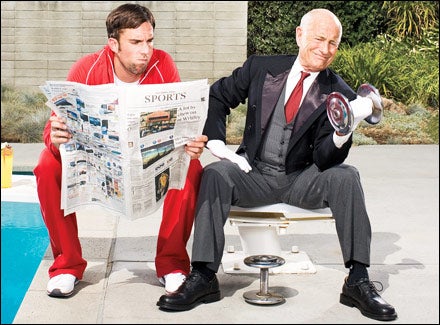Mistake #1
Training on Empty
Low-carb diets are great if your idea of exercise is walking to work. But athletes need to fuel up, and that means carbs. “Endurance athletes perform best on a diet that’s approximately 60 percent carbohydrate,” says John Seifert, professor of health and human development at Montana State University and a leading sports-nutrition researcher. Most people don’t eat enough carbs and don’t eat enough before big workouts causing them to exercise less intensely and therefore burn fewer calories.
The Fix: Experts say you should aim for 2.5 grams of carbs per pound of body weight every day. If you want to get a feel for this number, suffer through one day of strict carb counting and guesstimate from then on. Don’t want to do math at lunch? Just make sure the biggest portion of every meal is made up of healthy carbs, like fruits, brightly colored vegetables, and whole grains. If you’re going for a five-mile run, eat a carb-rich meal three hours beforehand. Example: 1 cup oatmeal with sliced banana, 8 oz low-fat yogurt, and 8 oz orange juice. Can’t afford to wait three hours? Eat a bowl of cereal before leaving the house, and down a sports drink while you work out.
Mistake #2
Fitness Mistakes
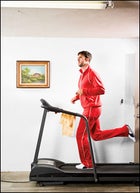
Working Out Just to Work Out
Your training should support the physical demands of your sport. Doing Olympic lifts to failure won’t improve your climbing endurance. Long-distance jogging doesn’t build the anaerobic capacity that hockey players need. And doing only two-leg strength exercises in the gym doesn’t make sense for start-and-stop sports like soccer, since running is an alternating single-leg activity.
The Fix: Make sure your workouts train the muscle groups you need. If your sport involves running, do some single-leg box jumps. If you’re an endurance biker, you need to convert some fast-twitch muscles to slow-twitch, so be sure to do the occasional weekend tour in which you ride all day at a leisurely tempo. And unless you’re a powerlifter, don’t lift weights to failure: it’ll just make you sore the next day.
Mistake #3
Living at the Gym
Sure, Equinox is convenient. But exercising indoors is boring, not to mention expensive. And oft-cited research shows it may not be as effective: Researchers at the University of Stockholm had athletes run at the same perceived exertion on an indoor treadmill and on an outdoor track. Result: They ran faster outdoors. Plus, if you’re like 40 percent of Americans, you don’t get enough vitamin D (conveniently provided by the sun). This deficiency can mean weak bones and skin whiter than Clay Aiken’s.
The Fix: Exercise outdoors at least half the time. Avoid treadmills. If you’re a gym rat, you can even modify your routines: Try doing lunges up a hill or using a park bench as a plyo box. And just because nobody really uses the chin-up bar on the fitness course at your local park doesn’t mean that you can’t.
Mistake #4
Stretching Cold
A flurry of new studies suggests that the age-old practice of static stretching (think the pregame ten-second toe touch) doesn’t reduce injury risk or improve performance. In fact, when done cold, aggressive static stretches can strain ligaments and tendons. “Static stretching isn’t sport-specific,” says Mike Rob┬şertson, president of Indianapolis-based Robertson Training Systems. “It increases passive range of motion, but athletes don’t need that. They need mobility.” Put it this way: If flexibility is the ability to touch your palms to the floor without bending your kneesÔÇöa good party trickÔÇömobility is the functional range of motion you need to take long freestyle strokes in the pool.
The Fix: Never stretch cold. Instead, warm up and then try some mobility exercises, such as simple walking lunges, which increase strength and efficiency when you’re moving through a normal range of motion. If you have a tendon or a muscle group that needs lengthening for your sport a tight shoulder, if you’re a swimmer, say be sure to get blood flowing through the muscles and tendons with a light warm-up before you stretch.
Mistake #5
Fitness Mistakes
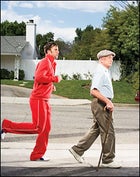
Going Long and Slow to Burn Calories
Most athletes looking to lose weight stick to long, slow cardio workouts, since the maximum fat-burning rate occurs at moderate exercise intensity (a.k.a. the fat zone). But if you’re looking to trim a belt size, you need to do high-intensity intervalsÔÇöthey simply burn far more calories overall. Plus high-intensity exercise ramps up your resting metabolism by stimulating what’s called excess post-exercise oxygen consumption (EPOC). “Your body will continue to burn calories as it replaces the oxygen you expended during your workout,” says Nick Winkelman, a performance specialist with Arizona-based Athletes’ Perfor┬şmance. Here’s a simple way of looking at it: To lose weight, you need to burn more energy than you take in. High-intensity training is the most effective way to do thisÔÇöespecially if you get only ten hours per week to work out.
The Fix: Replace one or two weekly endurance workouts with high-intensity intervals. Example: Warm up at 65 percent of your maximum heart rate (MHR) for five minutes and then do a one-to-two-minute interval at 90 to 95 percent of your MHR. Return to your warm-up pace until your heart rate drops back down to 65 percent of MHR. Repeat until you can no longer get down to 65 percent of MHR within a couple of minutesÔÇöthat is, until you’re sweating bullets. Then cool down.
Mistake #6
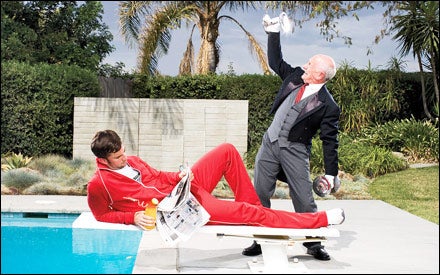
Ignoring Weights
Record-holding American distance runner Ryan Hall lifts weights. Michael Phelps swears by strength exercises. And in a recent study by the Norwegian University of Science and Technology, a group of competitive amateur athletes ran 21 percent longer at their maximum aerobic speed after doing half-squats for eight weeks. Translation: When done right, strength training improves efficiency and performance in endurance sports. Ignore weights and you won’t reach your peak.
The Fix: Add two resistance-training sessions to your weekly calendar. Focus on free-weight, multi-joint movements, like one-arm dumbbell snatches: Place a dumbbell on the floor between your legs, bend your knees and flex your hips, grab the dumbbell in one hand, bring it up to your chest, and lift it straight overhead. “Early on, do more repetitions and lighter loads,” says Eric Cressey, author of Maximum Strength. And don’t worry about bulking up: As long as you do enough aerobic exercise, you won’t turn into a meathead.
Mistake #7
Taking It Too Easy
Your go-to 2.5-mile jog is better than sitting on the couch, but unless you build on it, you’re standing in one place. “One of the basic tenets of exercise physiology is the principle of overload,” explains Stephen McGregor, director of the exercise-physiology lab at Eastern Michigan University. “This states that you can improve only by working a little harder than you have in the past.”
The Fix: Ramp it up. Slowly. Runners and cyclists: Start your interval routine with eight one-minute intervals at the fastest speed you can maintain (take two-minute recoveries in between). In each subsequent workout, do as many intervals as you can at the same speed until you can do 12, then increase your speed so that once again you can do only eight intervals. Just don’t overdo it.
Mistake #8
Skipping Recovery
When pro athletes aren’t training, they’re sleeping, eating, or lying on the couchÔÇörecovering. When you’re not training, you’re working or shoveling snow. “Even with a perfect training plan, someone who is in overdrive at work will eventually fall into classic overtraining and underperforming,” says Corey Hart, an exercise physiologist for the Idaho-based Physio Performance Lab.
The Fix: Pay attention to sleep (eight hours per night), energy level, and motivation. Whenever you underperform in two consecutive workouts, reduce your training by 50 percent until you feel reenergized. Every four weeks, take a planned recovery, in which you cut back on your workout time or intensity by 20 to 30 percent for a week.
Mistake #9
Fitness Mistakes
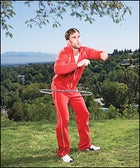
Moving in One Plane
There are three planes of movement: forward-backward, side-to-side, and rotational. Most guys exercise almost exclusively in the forward-backward plane (running, biking, bench presses). This leaves the muscles that control movement in the other planesÔÇösuch as the obliques, hip abductors, and shoulder rotatorsÔÇöunderdeveloped, sacrificing balance.
The Fix: Work rotational and side-to-side exercises into your routine. Even if you run 40 miles a week, targeting these muscles will improve your efficiency of movement. Start with single-leg exercises like lunges, then add a rotational elementÔÇöhold a medicine ball in front of your chest, arms extended, while rotating your trunk to one side with each lunge (e.g., left leg forward, rotate to the left). Try plyometric exercises like the lateral bound: Start from a standing position and jump as far as you can to the right. Land on your right foot, catch your balance, and bound as far as you can back to the left.
Mistake #10
Ab Obsession
You need a strong core, but most athletes isolate abdominal muscles and ignore everything that surrounds themÔÇöthe essential hip, trunk, and back muscles that extend off your core and make up your “pillar.” “Training your abs while ignoring the other parts of your pillar will throw the whole thing out of balance, leading to problems like lower-back pain,” says Paul Goldberg, the strength-and-conditioning coach for the NHL’s Colorado Avalanche and author of The Lean Look.
The Fix: Strengthen your lower back by doing reverse sit-ups on a medicine ball. To work your abs, back, and hip and shoulder stabilizers simultaneously, try some overhead squats: Stand with your arms extended straight overhead and a light dumbbell in each hand. Pull your navel toward your spine and then squat until your thighs are roughly parallel to the floor. Keep your core tight as you stand back up.
Mistake #11
Fitness Mistakes
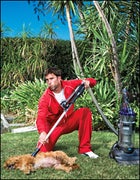
Pretending You’re Too Busy
This is the number-one excuse for not exercising. But your buddy with that annoying 10K habit is just as busy as you are. The real barrier is lack of consistent motivation. Or as ultramarathon man Dean Karnazes puts it, “Where there’s enough motivation to exercise, there’s always enough time to exercise.”
The Fix: The easiest way to get motivated is through competitionÔÇöthat’s why CrossFit, which keeps a score for every workout, has been so successful. Sign up for a century bike tour, marathon, triathlonÔÇöanything. Then find a partner (the alarm clock might not make you get out of bed, but a waiting buddy will) or join a training group (try , a social-networking site for athletes). Or just think about how you’ll feel after exercising. “Not once have I felt worse after finishing a run than I did before I started,” says Karnazes.
Mistake #12
Not Keeping Score
Keeping track of personal bests might sound like a diversion for fitness wonks, but there’s a reason why pro coaching outfits such as Athletes’ Performance do it: If you want to improve your fitness, you have to track your training. Exercise logs are like job evaluationsÔÇöwithout them, you don’t work as hard.
The Fix: Keep a training log. If you want to get obsessive about it, Web sites like Trainingpeaks.com, which tracks performance metrics such as speed and power output on bike rides, are great. Otherwise, a heart-rate monitor will do just fine. You ran four miles in 35:15, with a heart rate of 144 beats per minute yesterday? Match those numbersÔÇöor beat themÔÇöthe next time you go out.


